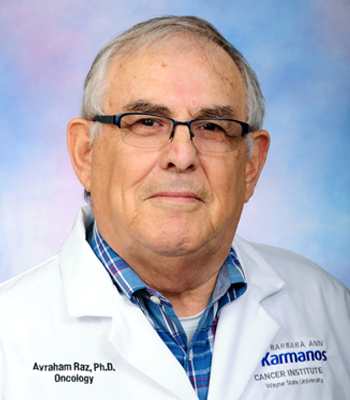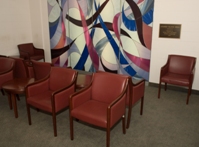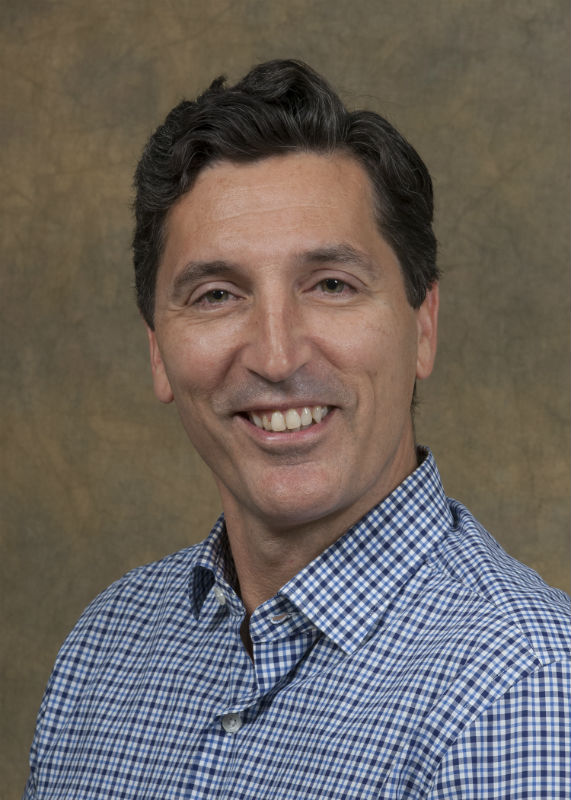Volume 1 Issue 3
16 August 2023
Welcome to the third edition of our faculty newsletter, Connect*. This quarterly newsletter (and soon, a website) disseminates content for the faculty, from the faculty. Our goal is to update, inform and enrich our faculty community. Connect strives to contain links to resources, upcoming events and more. As we engage each day in the School of Medicine’s mission, we bring with us our core values to create and maintain a culture of mutual respect with a genuine awareness of belonging for all faculty. Send questions, comments, content ideas and faculty news to SOMfacultyconnect@wayne.edu.
*Did you miss a previous issue of Connect? Find previous issues here: med.wayne.edu/faculty/newsletter-archive

Meet – Ophthalmology, Visual and Anatomical Sciences
| 
Mark Juzych, M.D. | 
Linda Hazlett, Ph.D. |
To learn how Mark Juzych, M.D., and Linda Hazlett, Ph.D., view the department's research strengths, faculty expertise and collaborations, jump to interview

New Faculty Hires
Welcome to our School of Medicine community! According to the Office of Faculty Affairs, these faculty have joined the Wayne State University School of Medicine since April.
Clinical:
- Samantha Bauer (Family Medicine)
- Emma Cermak (Obstetrics and Gynecology)
- Wael Dahhan (Internal Medicine/Gastroenterology)
- Shira Heisler (Internal Medicine/Infectious Diseases)
- Avnish Sandhu (Internal Medicine/Infectious Diseases)
- Yursa Shao (Oncology)
- Shazadie Soka (Psychiatry and Behavioral Neurosciences)
- Omar A. Soubani (Psychiatry and Behavioral Neurosciences)
Research:
If you see them in the hallway, we hope you have a chance to say hello!

Teaching and Mentoring
It’s the start of a new school year! There are 306 new M1 students, including six M.D./Ph.D. students. There also are 31 first-year Ph.D. students, including four M.D./Ph.D. students entering their doctoral (PhD) training phase. Seventeen of the incoming Ph.D. students are funded by the IBS program, 10 are funded by either departments, department Rumble assignments, or departmental discretionary GRAs.

Honors and Awards

Avraham Raz, Ph.D., the Paul Zuckerman Professor of Oncology and Pathology, has been appointed to the Academy of Scholars of Wayne State University. Founded in 1979, the Academy of Scholars is committed to recognizing outstanding excellence in scholarship and in creative achievement of the faculty members at Wayne State University. The academy's purpose is to raise the scholastic prestige of the university by bringing the most prominent academic experts to campus under its aegis and to create a community of scholars from among its most celebrated researchers. Dr. Raz is an outstanding researcher in the cancer metastasis field who received his doctoral degree from the prestigious Weizmann Institute of Science, Israel. Dr. Raz pioneered galectins research in cancer, identified the first “normal” chimeric gene-product (galectin 3) and characterized a novel cancer motility factor and its receptor that resulted in a new biological concept of “moonlighting proteins.” Dr. Raz held visiting professorships at national and international universities, is on the editorial boards of more than 20 journals, has mentored more than 50 post-doctoral fellows and is the editor-in-chief of Cancer Metastasis Reviews and the former president of the Metastasis Research Society. He serves as member of national, state, regional, private and international granting agencies, and was the first scientist from the State of Michigan to ever receive the MERIT Award from the National Cancer Institute of the National Institutes of Health. Dr. Raz’s groundbreaking discoveries have opened innovative strategies/avenues relevant to the understanding of cancer cell trafficking and signaling governing metastatic processes, and his work has been translated into the clinic. Congratulations, Dr. Raz, on this outstanding achievement!

Have you heard...?
Do you know who was awarded promotion and tenure? Check out the list at https://facaffairs.med.wayne.edu/ptawards
Also check out the faculty recognition awards at https://facaffairs.med.wayne.edu/awards

Wellness Corner
 Feeling stressed? Take a breather in the Faculty and Staff Meditative Epicenter in Room 2202 of Scott Hall. The room was designated for faculty and staff in 2009, when a new student meditation room was established in the Mazurek Medical Education Commons. A stained glass window and chairs help establish a calming area. (But please no food or beverages in the room.)
Feeling stressed? Take a breather in the Faculty and Staff Meditative Epicenter in Room 2202 of Scott Hall. The room was designated for faculty and staff in 2009, when a new student meditation room was established in the Mazurek Medical Education Commons. A stained glass window and chairs help establish a calming area. (But please no food or beverages in the room.)

News from our Labs
 Eric Sebzda, Ph.D.
Eric Sebzda, Ph.D.
The immune system destroys invading pathogens and prevents infectious disease. At the same time, it is vital that the immune system refrains from attacking self-tissues, otherwise serious pathology can occur. The process of restraining immune responses is termed “peripheral tolerance” and breakdowns in this process causes autoimmunity. Scientists now recognize that cancers co-opt peripheral tolerance mechanisms to avoid immune detection, thereby allowing tumors to become malignant. Eric Sebzda, Ph.D., an associate professor in the Department of Biochemistry, Microbiology and Immunology, recently received funding to investigate how unique aspects of peripheral tolerance impact cancer and autoimmunity. One project, “Identifying a KLF2-Dependent B-Cell Mechanism Responsible for Lupus” (DOD Lupus Research Program, Idea Award), tests the hypothesis that a subset of B cells found in body cavities prevents immunity directed toward commensal antigens and defects in this tolerance mechanism leads to autoimmune diseases, including lupus. Another project, “Identifying and Targeting a KLF2-Dependent T Cell Event to Treat Prostate Cancer” (American Cancer Society, Discovery Boost Grant), tests if eliminating a subset of inhibitory T cells is sufficient to treat lethal prostate cancer in mice. Heather Gibson, Ph.D., and Gregory Dyson, Ph.D., of the Barbara Ann Karmanos Cancer Institute are collaborators on the ACS study. Results from both projects will increase our understanding of peripheral tolerance and may lead to insights regarding the treatment of lupus and prostate cancer.

Events
Mark your calendars for these campus events and important dates!
- Expanded Programming for Interdisciplinary Collaboration to create Unique Research Missions (EPIC-URM) seminar series: Alternating Tuesdays (see: https://pharmacology.med.wayne.edu/epic-urm)
- M.S./Ph.D. student orientation: Aug. 24
- Faculty Fall Opening Brunch: Aug. 27, noon to 1:30 p.m., an opportunity to meet and welcome WSU’s new president, Kimberly Andrews Espy
- For a full calendar of fall opening events at WSU, click here (https://wayne.edu/fall-opening)
- First day of class for M.S./Ph.D. students: Aug. 28
- Fall break for M.S./Ph.D. students (no classes-new this year): Oct. 16-17
- Thanksgiving holiday: Nov. 23-26 (no classes for M.S./Ph.D. students Nov. 22)
- Last day of class for M.S./Ph.D. students, Dec. 11
Other Regional Events of Interest
Do you know of other events? Email the Connect team for events in the upcoming issue (next publication expected in December 2023) at SOMfacultyconnect@wayne.edu.

Coffee Hour
Ready to connect with faculty? Block out 3 to 4:30 the fourth Wednesday of each month- join us next on August, 23, 2023! Grab a coffee, meet colleagues, engage in casual conversation and just Connect!

Funding Opportunities
Looking for more internal and external funding opportunities? Check out this list on the School of Medicine webpage: https://somresearch.med.wayne.edu/research-opps
The Johns Hopkins University Research Office also has publicly available Excel/Google Docs lists of hundreds of fellowship opportunities for undergraduate, predoctoral, postdoctoral and underrepresented trainees at https://research.jhu.edu/rdt/funding-opportunities/

Resources
Collaborations are challenging, especially when you don’t know each other’s expertise. But the Research Development Committee of the School of Medicine Faculty Senate has put together a resource for us. Access the shared spreadsheet here] (requires AccessID login). Add or update your area of research and techniques to the list so School of Medicine faculty can find techniques or skills that can advance each other’s research.

Publications
Two impactful publications from the laboratory of Joongkyu Park, Ph.D., (Department of Pharmacology) were published recently. Check out the news articles for:
An article in Nature Communications from the lab of Maik Hutteman, Ph.D., (Center for Molecular Medicine and Genetics) and co-author Brian Edwards, Ph.D., (Biochemistry, Microbiology and Immunology), about cytochrome c in ischemic skeletal muscle was recently published: https://doi.org/10.1038/s41467-023-39820-8
Jeffrey Withey, Ph.D., (Biochemistry, Microbiology and Immunology) recently published a review article on cholera.
https://doi.org/10.3389/fmicb.2023.1178538 (2023)
Do you have a publication that should be highlighted? Maybe you wrote or received an editorial on a study? Let us know at SOMfacultyconnect@wayne.edu.

Meet – Ophthalmology, Visual and Anatomical Sciences
What are the major research areas of your department?
In 2018, after 20 years of close ties with Ophthalmology in faculty recruitment, collaborative research endeavors and shared office support staff, Mark Juzych, M.D., and Linda Hazlett, Ph.D., together with the enthusiastic support of the faculty of the two departments, voted to partner our endeavors into a new department, the Department of Ophthalmology Visual and Anatomical Sciences. The department’s mission is to vigorously enhance recruitment, collaborations and translational vision research at Wayne State University. This was enthusiastically approved by former dean Jack Sobel, M.D.; the provost; and the Board of Governors in 2018. Dr. Hazlett, Distinguished Professor and vice dean of Research and Graduate Programs, serves as vice chair of the department and holds the Robert S. Jampel, M.D., Ph.D., Endowed Chair in Ophthalmology. She also works with development, and in 2018, a new donor gift of $1.875 million was announced. The Knopper Family Endowed Chair (funded as an estate bequest) and the funded Knopper Family Endowed Research Fund. Ms. Knopper has contributed $575,000 to initially support Dr. Hazlett’s work in Pseudomonas keratitis and antimicrobial resistance and the role that particulates play in dry eye disease and its sequelae.
The P30 Core Vision Center grant from the National Eye Institute was originally secured by Harry Maisel, M.B., Ch.B., in 1982. Now, with the exciting opportunity brought about by the merger of the Department of Anatomy and Cell Biology and the Department of Ophthalmology, these cutting-edge basic science research investigations by multiple investigators have clinical application through increased translational studies. Dr. Juzych chairs the department, which is composed of clinicians and research and teaching faculty. The non-clinical component (Anatomical Sciences) of the department underwent changes in faculty with similar duties (research, teaching and service), with increases in allocated space for new faculty as needed. There was an increased effort by the vice chair to enhance recruitment of outstanding faculty in visual sciences and to promote and facilitate clinical/translational grant opportunities. The latter is facilitated through competitive applications for a Kresge Eye Institute Translational Research Innovation grant (KEI-TRIG) in which R01-funded (or those seeking funding) investigators partner with a clinician to propose a translational grant. This program, which has been in place the last nine years funding one or two grants ($25,000 to $50,000 awarded per year) is highly successful. Recently, we added a KEI-TRIG grant tailored for our postdocs and have awarded the first grant ($35,000) to Dr. Sneha Singh (senior postdoc) in the Kumar lab. These grants are specifically designed to foster new NEI R01 grant submissions.
What collaborations occur within your department?
A recent example of a translational approach to research is the collaboration of Dr. Thummel (basic science) with Drs. Lin and Abrams (clinicians) on vitreoretinopathy, which involved M.D./Ph.D. student Ashley Kramer and was supported by a KEI-TRIG grant. Drs. Abrams and Berkowitz have another project using OCT measurements to compare energy demands of the retina. They also were awarded a KEI-TRIG grant to support their work. Other collaborative projects include Drs. Ibrahim and Kowluru (both NEI R01 funded), who test the role of the Warburg effect on diabetic retinopathy; Drs. Thummel and Gow collaborate on vision defects associated with loss of C-Vps function using zebrafish and murine models. Dr. Hazlett collaborates with Dr. Xu (both NEI funded) to study the role of microRNAs in Pseudomonas keratitis. Dr. Kumar has numerous collaborations in his NEI R01 funded studies. He collaborates with the chair of Biochemistry, Microbiology and Immunology (Dr. Phil Pellett) on Zika virus (R21), as well as Dr. Juzych, and has collaborations at Henry Ford. He trains and interacts with fellows and clinical staff to develop research interests and collaborations. Drs. Berger (basic science) and Gabriel Sosne (clinician) collaborate on a project using thymosin beta 4 to potentiate antibiotics in bacterial infections. Several other collaborations exist: Drs. Hazlett and Berger with Dr. List, a cancer biologist brought into vision research by Dr. Hazlett, are studying the role of matriptase in cornea (R01 to be resubmitted in October). Drs. Hazlett and Zhang (a well-funded expert on metabolic effects of particulates and a member of the Center for Molecular Medicine and Genetics) continue their fruitful collaboration on the role of PM10 and the eye and await their Notice of Award. Two new investigators (Drs. List and Zhang) have been brought into vision research through these collaborations. And of course, all collaborations would not be possible without our dedicated research staff, graduate students, postdocs and research scientists, who make the department research enterprise work.
What collaborations occur with other departments/divisions/universities?
Dr. Renu Kowluru collaborates with Dr. Jay Ambati of the University of Virginia and Dr. Jian-Xia Ma of Wake Forest University. Dr. Steinle collaborates with Dr. Sui Wang of Stanford University and Mark Henkenmeyer at the University of Texas Southwestern. Dr. Berkowitz has a number of collaborations: University of Michigan (Sami Barmada, David Zacks and Geoffrey Murphy); Washington University (Rithwick Rajagopal); University of Bonn (Sarah Thiele); University College of London (Tom Burgoyne); University of Utah (Bryan Jones); University of Iowa (Shelia Baker); University of California Davis (David Bissig); University of California Irving (Vladimir Kefalov, Timothy Kern); the National Institutes of Health (Haohua Qian); The Ohio State University (Yanhui Ma); and the University of Buffalo (Steven Fliesler, Taosheng Huang). Dr Ichinose has a number of collaborations, including Dr. Zhang (Oakland University), Dr. Rob Smith (University of Pennsylvania), Dr. Bart Borghuis (University of Louisville) and Dr. Bo Hu (Methodist Hospital, Houston). Dr. Nantwi collaborates with Dr. Jason Matieka (Physiology) and with Dr. Maik Hutteman (Center for Molecular Medicine and Genetics) and Dr. Goebel with Dr. Hutteman. Dr. Bykhovskaia collaborates with Dr. Jeffery Ram (Department of Physiology) and with Dr. J. Troy Littleton of the Massachusetts Institute of Technology.
What should other faculty know about your department’s expertise to collaborate more?
The department is great at mentoring our post-docs and junior faculty and provides strong leadership and collaborations that result in additional R01s. For example, Dr. Kowluru is mentoring Dr. Ghulam Mohammed on investigating the epigenetic link between oxidative stress and inflammation in corneal wound healing in diabetes; he has a Michigan Eye Bank grant to support the work. Dr. Yu is mentoring Dr. Gao in preparation for an NEI R01 in the area of corneal wound healing. Dr. Kumar is mentoring Dr. Singh (senior research scientist in his lab) for studies on Zika virus and Dr. Sukhvinder Singh is also being mentored in pathogenesis studies. The Core Center grant also serves to assist new unfunded faculty in gathering preliminary data for NEI R01 submission. This is concretely evidenced in the co-recruitment of Dr. Andrew Garrett (primary Pharmacology and secondary appointment in OVAS), who joined WSU in July 2018. He has subsequently received an R01 and an R21 from the National Eye Institute to support his work on how developing neurons use cell-surface recognition molecules called cell adhesion molecules during neural circuit formation, collaborating with Dr. Ichinose. Dr. Ahmed Ibrahim (primary OVAS and secondary appointment in Pharmacology) was successfully mentored by Dr. Kowluru and received his first R01 dealing with the Warburg effect on diabetic retinopathy. All these collaborations are enhanced by the presence of the three research cores of the P30 grant, which continue (40 years) to support all facets (imaging, tissue culture, molecular and immunology expertise) of vision research projects at Wayne State University.
What is unique about your department’s teaching?
The department is unique among Ophthalmology departments in that we are dedicated to the teaching of foundational medical disciplines that include Gross Anatomy, Histology, Embryology and Neuroscience. We are fortunate to have a dedicated cadre of faculty, among them, Paul Walker, Ph.D., director of the Gross Anatomy and Neuroscience disciplines, and Rodney Braun, Ph.D., director of the Histology and Embryology disciplines. Paul also oversees Segment 1 (first nine months of the curriculum), and Rod is head of the Curriculum Management Committee. In addition, the two are co-directors of several systems-based courses in Segment 1. In addition, the clinical faculty spend many hours in training residents and fellows in Ophthalmology, training the next generation of physicians. Every faculty member is assigned a role in teaching.
What makes your department great?
There is not one thing, it is a combination of the people (faculty and staff), the research enthusiasm and collaboration, and clinical care (putting the patient first), and the leadership, that makes this department aspire to greatness.
What makes your staff great?
Besides being fantastic, and working as a team between the basic science and the clinical enterprise, they want to get things done; they are nimble and work with zeal and passion.

For more information about the Department of Ophthalmology, Visual and Anatomical Sciences, visit https://anatomy.med.wayne.edu/
Have an idea for our newsletter? Contact us at SOMfacultyconnect@wayne.edu.





 Feeling stressed? Take a breather in the Faculty and Staff Meditative Epicenter in Room 2202 of Scott Hall. The room was designated for faculty and staff in 2009, when a new student meditation room was established in the Mazurek Medical Education Commons. A stained glass window and chairs help establish a calming area. (But please no food or beverages in the room.)
Feeling stressed? Take a breather in the Faculty and Staff Meditative Epicenter in Room 2202 of Scott Hall. The room was designated for faculty and staff in 2009, when a new student meditation room was established in the Mazurek Medical Education Commons. A stained glass window and chairs help establish a calming area. (But please no food or beverages in the room.) Eric Sebzda, Ph.D.
Eric Sebzda, Ph.D.